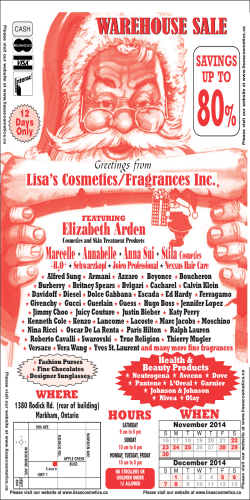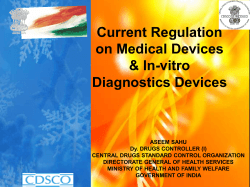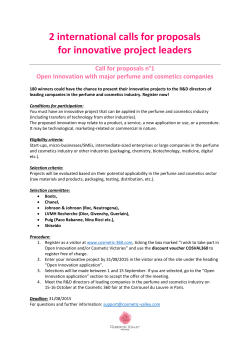
here - BEUC
EU position on cosmetics in TTIP Comparison between 2014 and 2015 versions May 2014 1. Introduction March 2015 1. Introduction The final report of the US - EU High Level Working Group on Jobs and Growth of February 2013 highlights that as regards regulatory aspects TTIP should contain, in addition to cross-cutting disciplines and TBT plus elements, provisions concerning individual sectors. The final report of the US - EU High Level Working Group on Jobs and Growth of February 2013 highlights that as regards regulatory aspects TTIP should contain, in addition to crosscutting disciplines and TBT plus elements, provisions concerning individual sectors. This paper outlines the main elements of a possible approach under TTIP to promote regulatory convergence in the cosmetics sector. These elements build on existing cooperation between EU and US regulators under ICCR (International Cooperation on Cosmetics Regulation). This paper outlines the main elements of a possible approach under TTIP to promote regulatory convergence in the cosmetics sector. These elements build on existing cooperation between EU and US regulators under the International Cooperation on Cosmetics Regulation (ICCR). It contains preliminary ideas that can be It contains preliminary ideas that can be complemented and refined at later stage. complemented and refined at later stage. The TTIP could cover: The TTIP could cover: mutual recognition of lists of allowed and prohibited cosmetic substances collaboration in good manufacturing practices and mutual recognition of inspection results collaboration in, and regulatory acceptance of, validated alternative test methods to animal testing harmonization of test methods (based on ISO standards) and test requirements approximation of labelling requirements strengthening the harmonization work carried at international level under ICCR reinforcing regulatory cooperation on emerging areas. collaboration in scientific safety assessment methods, collaboration in good manufacturing practices and mutual recognition of inspection results collaboration in, and regulatory acceptance of, validated alternative test methods to animal testing harmonisation of test methods (based on ISO standards) and test requirements approximation of labelling requirements strengthening the harmonisation work carried out at international level under ICCR reinforcing regulatory cooperation on emerging areas. The discussions are at a relatively early stage and therefore the specific actions that may be decided cannot yet be determined. But these proposed items could result in gains not only for industry arising from reduction of diverging requirements, but also in: a wider range of cosmetics products more efficient testing, and greater international harmonisation of cosmetics regulations and practices. The discussions are still ongoing and therefore the specific actions have not yet been decided. In any case, these proposed items could result in gains not only for industry arising from reduction of diverging requirements, but also in: a wider range of cosmetics products available to the consumer more efficient testing, and greater international harmonisation of cosmetics regulations and practices. This could be achieved without This would be achieved without compromising the protection of public policy compromising the protection of public policy interests such as health or animal welfare interests such as health or animal welfare 2. Possible elements for a cosmetics annex 2. Possible elements for a cosmetics annex in TTIP in TTIP 2.1. Mutual recognition of lists of substances 2.1. Convergence of data requirements and that can be used in cosmetic products scientific safety assessment methods (positive lists) and of lists of substances that are prohibited or restricted in cosmetic products (negative list) The EU Cosmetics Regulation contains lists of substances authorized for use in cosmetic products as colorants (listed in Annex IV), as preservatives (listed in Annex V), and as UV filters (listed in Annex VI). The EU Regulation contains also lists of prohibited substances in cosmetics (Annex II) and substances subject to specific restrictions (Annex III). The EU Cosmetics Regulation contains lists of substances authorised for use in cosmetic products as colorants (listed in Annex IV), as preservatives (listed in Annex V), and as UV filters (listed in Annex VI). Both Parties could explore possibilities for the approximation and mutual recognition of cosmetic ingredients that are allowed in cosmetic products. Both Parties could endeavour to align their data requirements and scientific safety assessment methods for cosmetic ingredients that must be assessed and authorised for use in cosmetic products. For instance, only assessed and authorised For instance, only assessed and authorised UV filters can be used in sunscreens in the UV filters can be used in sunscreens in the EU. EU. In the US, sunscreens are classified as In the US, sunscreens are classified as over-the over-the counter (OTC) drugs requiring thorough safety assessment and authorisation. Both Parties could discuss possibilities to mutually recognize scientific findings on the safety of UV-filters used in sunscreens. counter (OTC) drugs requiring also thorough safety assessment and authorisation. Both Parties could discuss possibilities to share scientific findings on the safety of UV-filters used in sunscreens. The idea would be to facilitate the authorisation procedure for UVfilters in one market that are proved to be safe and therefore allowed in the other market. 2.2. Good Manufacturing Practices (regulatory recognition of the international standard ISO 22716 on cosmetics, and recognition of GMP inspections for OTCs) 2.2. Good Manufacturing Practices (regulatory recognition of the international standard ISO 22716 on cosmetics, and recognition of GMP inspections for OTCs) Both in the EU as in the US manufacturers have to comply with cosmetics good manufacturing practices. The European standard on cosmetics GMP is fully aligned with the international standard ISO 22716 on cosmetics GMP. FDA guidance has been recently modified so as to align it with ISO 22716. Both, in the EU and the US manufacturers have to comply with cosmetics good manufacturing practices. The European standard on cosmetics Good Manufacturing Practices (GMP) is fully aligned with the international standard ISO 22716 on cosmetics GMP. US Food and Drug Administration (FDA) guidance has been recently modified so as to align it with ISO 22716. Both Parties should agree on formally recognising that compliance with ISO 22716 is sufficient for regulatory purposes and work towards elimination of any differences between own standards/guidance and ISO 22716 if at all existent. Both Parties should agree on formally recognising that compliance with ISO 22716 is sufficient for regulatory purposes and work towards elimination of any differences between own standards/guidance and ISO 22716 if at all existent. For products classified as OTC drugs in the US, compliance with pharma GMP is required as well as factory inspections carried out by FDA. In this context, the acceptance of GMP inspections carried out by the other Party could be explored. For products classified as over-the counter (OTC) drugs in the US, compliance with pharma GMP is required as well as factory inspections carried out by the FDA. In this context, it would be useful to explore whether the compliance with ISO GMP standard for cosmetics would be sufficient also for cosmetic products classified as OTC drugs, or whether the results of GMP Pharma inspections carried out by authorities in the EU could be accepted as an alternative. 2.3. Formal regulatory acceptance of 2.3. Formal regulatory acceptance of validated alternative tests methods to validated alternative tests methods to animal testing animal testing Several alternative tests methods (ATMs) to Several alternative tests methods (ATMs) to animal testing have been validated and animal testing have been validated and adopted as OECD test guidelines. adopted as OECD test guidelines. Both Parties could agree on further fostering the development of alternative methods for animal testing. The overall objective is to encourage the US to formally accept validated test methods for regulatory purposes for cosmetics, in particular for products being classified as OTC drugs in the US. Both Parties could agree on further fostering the development of alternative methods to replace animal testing. The overall objective is to promote the use of validated and OECD accepted alternative test methods for regulatory purposes for cosmetics. Both sides could share scientific knowledge on the matter including existing technical assessments and guidance documents, and could collaborate in the development and implementation of the 'read across data approach and integrated testing strategies' that use all available information and data. Both sides could share scientific knowledge on the matter including existing technical assessments and guidance documents, and could collaborate in the development and implementation of the 'read across data approach and integrated testing strategies' that use all available information and data. 2.4. Harmonization of other test methods 2.4. Harmonisation of other test methods and of test requirements and of test requirements Both sides should further cooperate on the harmonization of test methods on basis of ISO standards (e.g. ISO 24445 – test methods to determine the sun protecting factor) Both sides should further cooperate on the harmonisation of test methods on the basis of ISO standards (e.g. ISO 24445 - test methods to determine the sun protecting factor). Both sides could explore possibilities for the approximation of requirements regarding colour additives (EU allows those on the list of authorized colorants without further testing. US-FDA has to approve all colour additives (ingredient pre-approval) and for certain colour additives batch testing is required). Both sides could explore possibilities for the approximation of requirements regarding colour additives (The EU allows those that are on the list of authorised colorants without further testing. In the US for certain colour additives batch testing is required). The possibility to waive 'batch testing' of OTC drugs manufactured with ingredients considered safe by both sides (including purity levels), could be explored (in case existing legislation allows it). In that case, safety compliance could be checked via inspections on a random basis. The possibility to waive 'batch testing' of colorants considered safe by both sides (including purity levels), could be explored (in case existing legislation allows it). In that case, safety compliance could be checked via inspections on a random basis. 2.5. Approximation of labelling requirements 2.5. Approximation of labelling requirements Both sides could work on further aligning labelling requirements on the basis of the International Nomenclature for Cosmetic Ingredients (INCI system) in particular as regards trivial names (e.g. acceptance of the term aqua as alternative to water). Both sides could work on further aligning labelling requirements on the basis of the International Nomenclature for Cosmetic Ingredients (INCI system) in particular as regards trivial names. Other labelling requirements could be harmonized (e.g. sunscreen protection factor (SFP) based on common ISO test methods) as well as the labelling of colour ingredients (FDA using INCI names and EU requiring colour index number). Other labelling requirements could be harmonized (e.g. sunscreen protection factor (SFP) based on common ISO test methods) as well as the labelling of colour ingredients (FDA using INCI names and EU requiring colour index number). In addition, both parties could pursue In addition, both parties could pursue collaboration in emerging issues such as collaboration in new issues such as allergen allergen labelling. For instance, scientific labelling. opinions underpinning regulatory decisions on fragrances allergen labelling could be shared. 2.6. Reinforce cooperation within ICCR 2.6. Reinforce cooperation within ICCR Both parties could commit to further strengthen their cooperation within ICCR and discuss ways to implement ICCR decisions in their jurisdictions, as well as bringing a political commitment to reinforce the impetus of ICCR work. Both parties could commit to further strengthen their cooperation within ICCR and discuss ways to implement ICCR decisions in their jurisdictions, as well as bringing a political commitment to reinforce the impetus of ICCR work. 2.7. Reinforce regulatory cooperation on 2.7. Reinforce regulatory cooperation in new areas emerging areas Both Parties could cooperate in good Both Parties could cooperate in new issues regulatory practices on emerging issues, for and consider developing disciplines and instance with respect to nanotechnology or principles aimed at good regulatory practices alternative test methods, and consider specific to the cosmetics sector, without developing disciplines and principles aimed duplication of the work done in the ICCR. at good regulatory practices specific to the cosmetics sector, without duplication of the work done in the ICCR
© Copyright 2025











